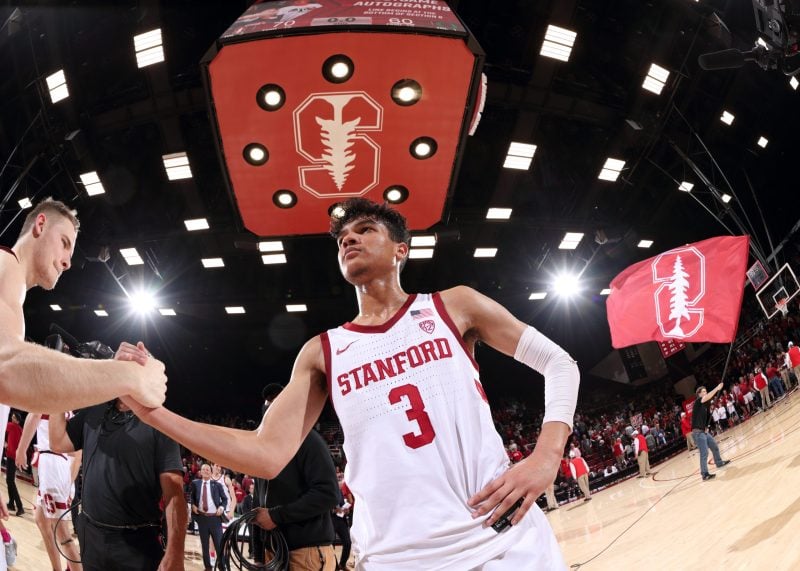On April 6, Stanford men’s basketball freshman-phenom guard Tyrell Terry announced via his Instagram that he would forego his college eligibility and declare for the NBA Draft. Terry, who arrived at Stanford from DeLaSalle High School in Minneapolis, Minnesota, started 31 of Stanford’s 32 games. He averaged 14.6 points per game while maintaining a 89.1% success rate from the charity stripe and shooting 40.8% from beyond the arc.
While Terry’s draft stock varies based on which analyst or website you prefer, the consensus has Terry being picked either in the late first round or the early second. ESPN ranks Terry as the 21st-best point guard and 62nd-best overall player eligible for the 2020 NBA Draft. Per the current NCAA rules, Terry has until June 3 to withdraw from the draft, which will be held June 25, and retain his eligibility and the option to return to Stanford.
With such a large number of Cardinal players returning for the 2020-21 season along with the highest-ranked recruiting class in the Pac-12, another year on the Farm would provide Terry with the opportunity for valuable physical growth and development as a player. Another season of collegiate play gives the 6’2″, 160-pound guard the chance to better his stats, build more muscle and, consequently, improve his draft grade for the 2021 NBA Draft instead.
Better stats is a better draft position
Last year, with Terry at the helm, Stanford’s (20-12, 9-9 Pac 12) season was a rollercoaster. Glimpses of greatness, such as an upset win over Oregon in February and a 15-2 start to the season, revealed the team’s potential; but a 4-7 record in the last 11 games and a disappointing, early exit in the Pac-12 tournament to rival Cal highlighted the need for further improvement.
That being said, the 2019-20 team drew attention and set expectations for the program to take the next step in the 2020-21 season. The recent addition of consensus five-star Ziaire Williams to the 2020 recruiting class puts the Cardinal in a position to reach levels of success that have not been reached in decades.
If Terry made the decision to return for a sophomore campaign, he would be playing alongside returning starters such as standout forward Oscar da Silva, who averaged a team-high 15.7 points and 6.4 rebounds per game, forward Spencer Jones, whose 43.1% 3-point shooting led the team and guard Daejon Davis, who snagged 55 steals in 32 games.
The simple fact that Terry will be surrounded by the same players from last year, in addition to a new group of talented freshmen, will allow him not only to score, but to dish the ball at an even greater level.
Another year on the Farm also allows Terry to continue to play under Cardinal head coach Jerod Haase, who has strong confidence in Terry’s abilities and provides him the flexibility to control the flow of any game.
Another year to add muscle
Making the transition from college basketball to the NBA is no easy feat. From roughly 35 NCAA games that are 40 minutes each to 82 48-minute games in the NBA, this increase takes a physical toll on all players. Not to mention, NBA players are often much bigger and more developed than their collegiate counterparts.
While Terry has the height to compete with any NBA point guard, his build is smaller than many starting NBA point guards. Warriors superstar Steph Curry is listed at 185 pounds, while Kyrie Irving and Derrick Rose weigh in at 195 and 200, respectively.
By returning for a sophmore year at Stanford, Terry will be able to spend another year in the weight room and add more muscle while continuing to compete in a field of play where the average size difference between him and his opponents is less stark.
Not only would an additional 15 pounds of muscle allow him to be better physically suited to handle an 82-game season, but it would also better prepare him to guard faster and stronger players in the NBA. By presenting himself at 6’2″ and 175 pounds, Terry will improve his draft stock even if he performs at a level similar to that of his freshman year.
Non-draft considerations
There are other non-draft-related considerations that make a strong case to return to the Farm. Another year on the Farm would be another step closer to a Stanford degree. As it inevitably does for all players, basketball will eventually end for Terry. By putting more time into his degree now, Terry makes the task of completing his degree after the NBA that much easier.
Additionally, the decision to leave Stanford strips the phenom of the chance to etch his name into the school’s history books. The 2020 Cardinal basketball team looks poised to make an NCAA tournament run, with CBS Sports including Stanford in its current Preseason Top 25 poll. If Terry returns and leads the Cardinal team to just their first NCAA tournament since 2014, he will be remembered in Stanford lore. While these considerations may not directly help his draft stock, they do provide more personal reasons to return for a second year.
By withdrawing from the draft and returning to Stanford for his sophomore campaign, Terry gives himself a strong opportunity to raise his draft stock and solidify himself as a first round draft pick. Rather than have to haggle over a rookie contract as a second round draft pick, Terry would be able to utilize the NBA Rookie Scale, which applies only to first round picks, allowing him to receive much more guaranteed money.
Regardless of how he decides, Terry played a critical role in the 2019-20 team, setting Stanford up for success in the near future. And quite honestly, with his talent and dedication to the game, there is no wrong answer. So Ty, do what is best for you, but remember, there’s no place quite like the Farm.
Contact Jacob Neidig at jhneidig ‘at’ stanford.edu.
